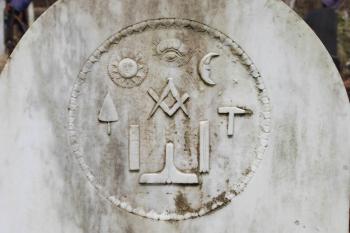Glossaries
| Term | Definition |
|---|---|
| all-seeing eye |
Traditionally, the eye is seen as the mirror of the soul, but especially as the Divine Eye. The use of the eye as a symbol is therefore older than Christianity. For example, in Ancient Egypt, the Eye of Horus symbolized protection, royal power, and good health. The right eye of the god Horus was also associated with the sun god Ra and was therefore also called the Eye of Ra. The Eye of Horus was given to deceased pharaohs in the form of an amulet to protect them in the afterlife. In the Bible the eye is used as a symbol of divine omniscience and of paternal care, see for example Psalm 34:15 (KJ): "The eyes of the Lord are upon the righteous [...]." Often the eye of God is depicted in a triangle, sometimes with sun rays. That triangle is the emblem of the Trinity or Trinity, the theological view that God is composed of three entities, the Father, the Son and the Holy Spirit. The sun's rays symbolize life force and immortality. In cemeteries, the symbol is mainly found on funerary monuments between 1850 and 1900, a period when more use was made of old classical symbolism, such as the ouroboros, the tail-biting snake, which also has an origin in Ancient Egypt. Within European painting and architecture, the All-Seeing Eye was already used in the seventeenth century and the symbol can be found in various Dutch churches, for example as a ceiling painting. Today, the all-seeing eye is mainly associated with Freemasonry, although it only plays a minor role in it. Conspiracy theorists see it as the influence of Freemasonry on world domination, especially the history of the United States. However, the use of the symbol is much older and also occurs in Hinduism, for example. Nederlands:Alziend oog. Van oudsher wordt het oog gezien als de spiegel van de ziel, maar vooral als het Goddelijk Oog. Het gebruik van het oog als symbool is dan ook ouder dan het christendom. Zo symboliseerde in het Oude Egypte het Oog van Horus bescherming, koninklijke macht en goede gezondheid. Het rechteroog van de god Horus werd ook geassocieerd met de zonnegod Ra en werd daarom ook wel het Oog van Ra genoemd. Het Oog van Horus werd in de vorm van een amulet aan overleden farao's meegegeven om hen te beschermen in het hiernamaals. In de bijbel wordt het oog gebruikt als een symbool van de goddelijke alwetendheid en van de vaderlijke zorg, zie bijvoorbeeld Psalm 34:16: 'Het oog van de Heer rust op de rechtvaardigen'. Vaak wordt het oog van God weergegeven in een driehoek, soms met zonnestralen. Die driehoek is het zinnebeeld van de Drie-eenheid of Drievuldigheid, de theologische opvatting dat God bestaat uit drie entiteiten, de Vader, de Zoon en de Heilige Geest. De zonnestralen symboliseren levenskracht en onsterfelijkheid. Het symbool komt op begraafplaatsen vooral voor op grafmonumenten tussen 1850 en 1900, een periode waarin meer gebruik werd gemaakt van oude klassieke symboliek, zoals de ouroboros, de staartbijtende slang, die ook een herkomst heeft in het Oude Egypte. Binnen de Europese schilder- en bouwkunst wordt het Alziend Oog al in de zeventiende eeuw toegepast en het symbool is in verschillende Nederlandse kerken te vinden, bijvoorbeeld als plafondschildering. Tegenwoordig wordt het Alziend Oog vooral geassocieerd met de vrijmetselarij, hoewel het daar slechts een kleine rol in vervult. Complottheoretici zien er de invloed in van de vrijmetselarij op de wereldheerschappij, met name de onstaansgeschiedenis van de Verenigde Staten. Het gebruik van het symbool is echter al veel ouder en komt bijvoorbeeld ook voor binnen het hindoeïsme. |



